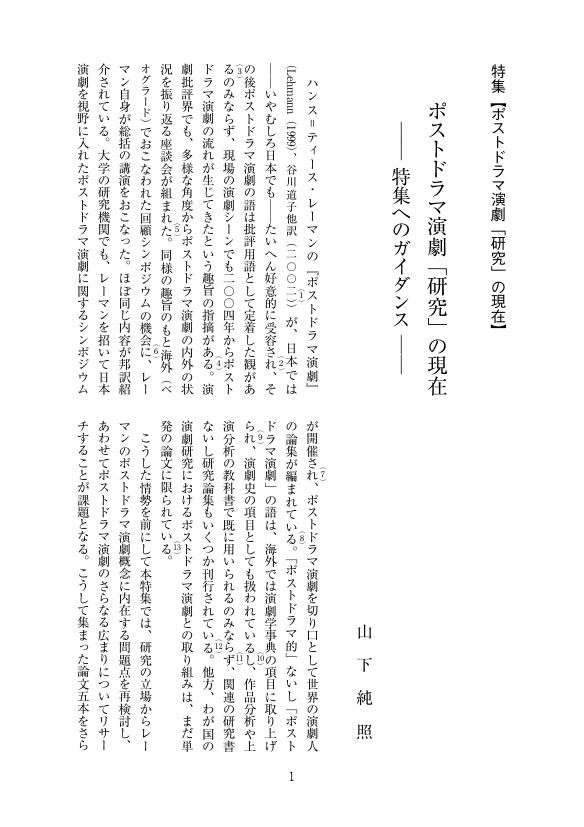9 0 0 0 OA 戦時演劇研究 ―成果と展望
- 著者
- 日比野 啓 林 廣親 山下 純照
- 出版者
- 日本演劇学会
- 雑誌
- 演劇学論集 日本演劇学会紀要 (ISSN:13482815)
- 巻号頁・発行日
- vol.49, pp.3-25, 2009 (Released:2018-01-12)
This paper first addresses the general academic inertia in the research on Japanese theatre during the Fifteen-Years War (1931-1945). A few shingeki-centered studies have emphasized the government's repression of theatre, but more detailed, evidence-based examination (rather than emotionally charged accusations based on limited experiences on the part of “victims”) will reveal the complex and complicated situation in which Japanese theatre was bogged down from 1931 through 1945.Second, it redefines Ozasa Yoshio's argument that the “National Theatre” (kokumin engeki) concept was not a detestably successful example of the nation's cultural control but a failed enterprise broadly supported by theatre practitioners who were encouraged by the nation's first attempt to support theatre. The National Theatre concept was so abstract and vague that government official, critics and scholars, shingeki people, and production companies could put their different ideals and plans on it, with the result that it failed to provide a unified vision of the National Theatre, whether it was based on shingeki or kabuki.Third, it proposes a new perspective on mobile theatre. The “uncontrollability” of theatre arts was most tellingly reflected in the realities of Japanese mobile theatre during World War II. These realities should be further examined not only by excavating unfound documents told by the performers and the leaders of the mobile theatre, but also by exploring the experiences of audiences in villages and factories.Lastly, the paper concludes that unlike the Nazi Theatre, which Japanese government official and scholars set an example of, Japanese theatre during the Fifteen-Years War was not so organized or unified that the government could control its broad activities. Although research on the influences of the Nazi theatre policies on Japan's National Theatre concept should be continued, they are expected to be limited ones.
6 0 0 0 OA 《西洋比較演劇研究会 例会記録と報告》 2022年度(2022年4月~2023年3月)
- 著者
- 山下 純照
- 出版者
- 成城大学大学院文学研究科
- 雑誌
- 美学美術史論集 = Aesthetics and art history (ISSN:09132465)
- 巻号頁・発行日
- vol.22, pp.202-185, 2020-03
石鍋真澄教授退任記念
- 著者
- 山下 純照
- 出版者
- 美学会
- 雑誌
- 美学 (ISSN:05200962)
- 巻号頁・発行日
- vol.62, no.2, pp.144, 2011-12-31 (Released:2017-05-22)
1 0 0 0 OA ポストドラマ演劇「研究」の現在
- 著者
- 山下 純照
- 出版者
- 日本演劇学会
- 雑誌
- 演劇学論集 日本演劇学会紀要 (ISSN:13482815)
- 巻号頁・発行日
- vol.67, pp.1-8, 2019-03-15 (Released:2019-03-20)
1 0 0 0 戦時演劇研究--成果と展望 (特集 戦時演劇)
演劇教育の実態調査を、目本演劇学会の会員を対象に、3度にわたって行ない、その分析を試みた。さらにはインターネットのホームページその他で、演劇教育関連科目の情報を集め、これを整理、分析し、演劇教育の実態を探る試みを行なった。また、演劇教育の方法を構築するための内容探求のため、科研費研究メンバーでの研修会を持ち、さらには、規模を大きくした演劇教育コロキウムを2年にわたって開催した。(1)2003年度には、8月に演劇教育の事例報告を中心にした研修会。大学演劇教育を考える基礎がためのため、10月と翌年1月に、宝塚北高校、神奈川総合高校の現場で2校の演劇教育の実際を材料に研修した。そして2月に演劇教育のコロキウムを開催した。大学演劇教育においては、演劇専攻を設置する大学と設置しない大学、あるいは、実技科目を設置する大学と設置しない大学、などの多様な軸を見据えて討論した。(2)2004年度は、8月に演劇教育の研究を深めて行く更なる方法の討議を行なう研修会を持ち。12月に、演劇教育を専門とする大学の授業と普通授業に演劇的手法を用いた演劇授業の2つの大学における演劇教育の現場を材料に研修会を行なった。そして、昨年度に続いて演劇教育コロキウムを3月に開催した。第1部は、「外国における演劇教育研究」で、<英米およびポーランドの高等教育機関における演劇教育とその研究をめぐって>を、第二部では、12月に研究対象とした2つの大学の演劇教育の姿を討論材料に討議を進め、第三部では、<これからの演劇教育>のタイトルのもとで、イ)学部に演劇教育の専門コースを設置し、尚且つ実技を伴う授業を設置。ロ)学部に演劇教育の専門コースを設置するが、理論(座学)中心の演劇教育を設置、などの5つのタイプをもった大学の演劇教育の姿の基に討議するコロキウムを行なった。これらの成果は、来年の「日本演劇学会紀要」にまとめる計画である。


